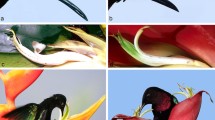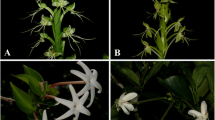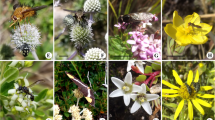Summary
In cloud forest at Monteverde, Costa Rica, two common treelets (Palicourea lasiorrachis and Cephaelis elata, both Rubiaceae) depend simultaneously on one hummingbird population (Lampornis calolaema) for pollination. Both species are distylous and self-incompatible. In laboratory experiments, we examined possible effects of indiscriminate foraging by hummingbirds among flowers of both species, as observed in the field, on pollination of Palicourea. In each of 35 trials, captive L. calolaema probed 2 flowers from pin plants of Palicourea followed by 20 thrum flowers of the same species, with either 0, 2, or 10 Cephaelis flowers intervening. We assessed pollen transfer by staining and counting pin pollen tubes growing in thrum styles; counts of 0, 1, or ≥2 pollen tubes relate directly to seed output (0, 1, or 2 seeds per fruit, respectively). Intervening Cephaelis flowers sharply reduced pollen receipt by thrum flowers of Palicourea and reduced some aspects of pollen dispersal from pins as well, thereby curtailing maternal and paternal reproductive potential of Palicourea. Such effects of interspecific pollen loss on reproductive output may lead to strong competition among some, though not all, combinations of plant species pollinated by L. calolaema or of other plant combinations that share animal pollinators.
Similar content being viewed by others
References
Bawa KS, Beach JH (1983) Self-incompatibility systems in the Rubiaceae of a tropical lowland wet forest. Am J Bot 70:1281–1288
Bir Bahadur (1970) Heterostyly in Rubiacea: a review. J Osmania Univ (Science), Golden Jubilee Vol: 207–238
Campbell DR (1985a) Pollen and gene dispersal: the influences of competition for pollination. Evolution 39:418–431
Campbell DR (1985b) Pollinator sharing and seed set of Stellaria pubera: competition for pollination. Ecology 66:544–553
Campbell DR, Motten AF (1985) The mechanism of competition for pollination between two forest herbs. Ecology 66:554–563
Darwin C (1888) The different forms of flowers on plants of the same species, 2nd ed. John Murray, London
Feinsinger P (1987) Effects of plant species on each other's pollination: is community structure influenced? Trends in Ecology and Evolution 2:123–126
Feinsinger P, Busby WH (1987) Pollen carryover: experimental comparisons between morphs of Palicourea lasiorrachis (Rubiaceae), a distylous, bird-pollinated, tropical treelet. Oecologia (Berlin) 73:231–235
Feinsinger P, Murray KG, Kinsman S, Busby WH (1986) Floral neighborhood and pollination success in four hummingbird-pollinated cloud forest plant species. Ecology 67:449–464
Feinsinger P, Beach JH, Linhart YB, Busby WH, Murray KG (1987) Disturbance, pollinator predictability, and pollination success among Costa Rican cloud forest plants. Ecology 68:1294–1305
Ganders FB (1979) The biology of heterostyly. NZ J Bot 17:607–635
Kohn JR, Waser NM (1985) The effect of Delphinium nelsonii pollen on seed set in Ipomopsis aggregata, a competitor for hummingbird pollination. Am J Bot 72:1144–1148
Martin FW (1959) Staining and observing pollen tubes in the style by means of fluorescence. Stain Technol 34:125–128
Mulcahy DL, Curtis PS, Snow AA (1983) Pollen competition in a natural population. In: Jones CE, Little RJ (eds) Handbook of experimental pollination biology. Van Nostrand Reinhold, NY, pp 330–337
Murray KG, Feinsinger P, Busby WH, Linhart YB, Beach JH, Kinsman S (1987) Evaluation of character displacement among plants in two tropical pollination guilds. Ecology 68:1283–1293
Rathcke BJ (1983) Competition and facilitation among plants for pollination. In: Jones CE, Little RJ (eds) Handbook of experimental pollination biology. Van Nostrand Reinhold, NY, pp 305–329
Snow AA (1986) Pollination dynamics in Epibolium canum (Onagraceae): consequences for gametophytic selection. Am J Bot 73:139–151
Sobrevila C, Ramirez N, Xena de Enrech N (1983) Reproductive biology of Palicourea fendleri and P. petiolaris (Rubiaceae) heterostylous shrubs of a tropical cloud forest. Biotropica 15:161–169
Waser NM (1978a) Competition for hummingbird pollination and sequential flowering in two Colorado wildflowers. Ecology 59:939–944
Waser NM (1978b) Interspecific pollen transfer and competition between co-occurring plant species. Oecologia (Berlin) 55:251–257
Waser NM (1983) Competition for pollination and floral character differences among sympatric plant species: a review of evidence. In: Jones CE, Little RJ (eds) Handbook of experimental pollination biology. Van Nostrand Reinhold, NY, pp 277–293
Waser NM, Fugate ML (1986) Pollen precedence and stigma closure: a mechanism of competition for pollination between Delphinium nelsonii and Ipomopsis aggregata. Oecologia (Berlin) 70:573–577
Author information
Authors and Affiliations
Rights and permissions
About this article
Cite this article
Feinsinger, P., Busby, W.H. & Tiebout, H.M. Effects of indiscriminate foraging by tropical hummingbirds on pollination and plant reproductive success: experiments with two tropical treelets (Rubiaceae). Oecologia 76, 471–474 (1988). https://doi.org/10.1007/BF00377045
Received:
Issue Date:
DOI: https://doi.org/10.1007/BF00377045




